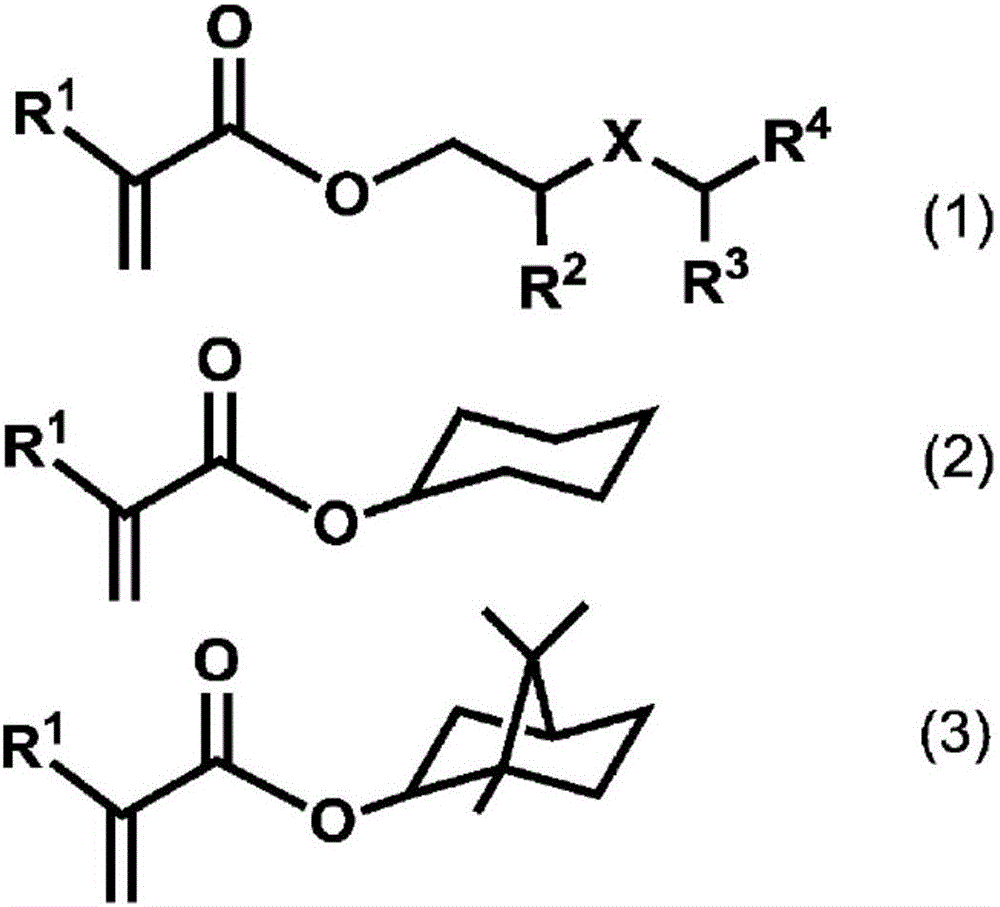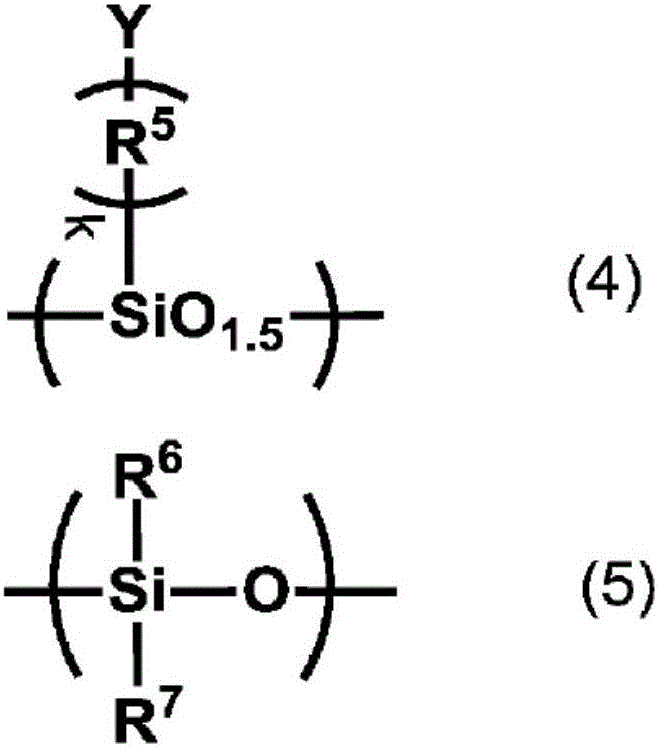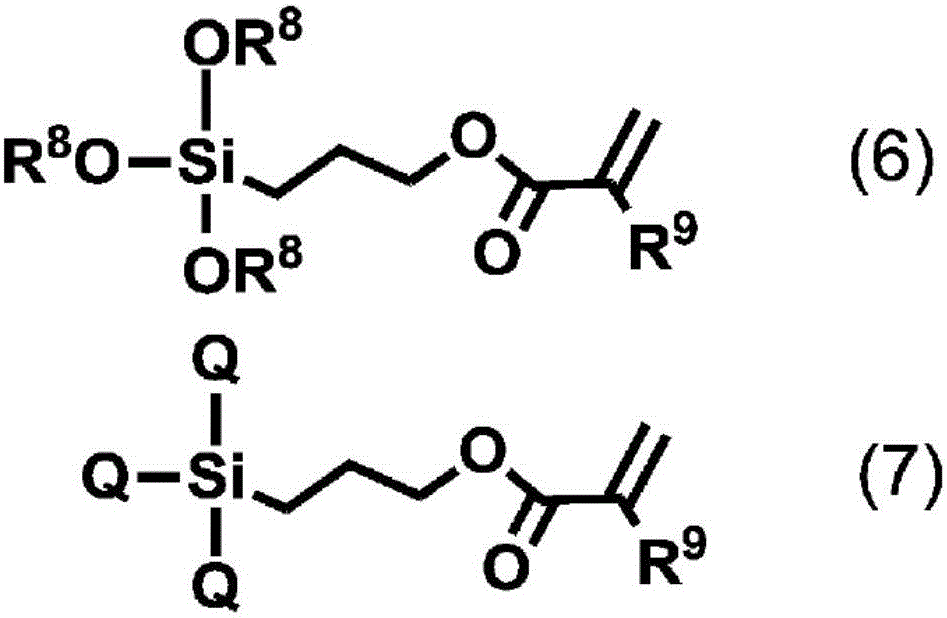Imprinting material
一种基材、质量份的技术,应用在薄料处理、仪器、电气元件等方向,能够解决低脱模力、低塑性变形性等问题,达到低脱模力性、低塑性变形性、放大工艺裕量的效果
- Summary
- Abstract
- Description
- Claims
- Application Information
AI Technical Summary
Problems solved by technology
Method used
Image
Examples
Embodiment
[0105] Hereinafter, although an Example and a comparative example are given and this invention is demonstrated in more detail, this invention is not limited to these Examples.
[0106] The weight-average molecular weights of the silsesquioxane compounds obtained from Synthesis Example 1 and Synthesis Example 2 and the weight-average molecular weights of X-22-1602 and X-22-164, which are organosilicon compounds, obtained by gel permeation Chromatography (hereinafter, abbreviated as GPC in this specification) is the measurement result obtained. For the measurement, a GPC system manufactured by Tosoh Technology Co., Ltd. was used. The configuration and measurement conditions of this GPC system are as follows.
[0107] GPC main body: HLC-8320GPC
[0108] GPC column: Shodex (registered trademark) LF-804
[0109] Column temperature: 40°C
[0110] Solvent: THF
[0111] Flow rate: 1mL / min
[0112] Standard sample: 6 kinds of polystyrene with different weight average molecular we...
Synthetic example 1
[0114] In a 2000mL four-neck flask, add 486.98g of 3-acryloyloxypropyltrimethoxysilane and 400.53g of methanol, cool to 10°C while stirring, and add 0.1N hydrochloric acid dropwise at 10°C to 25°C for 30 minutes A mixed solution of 112.23 g of aqueous solution and 200.26 g of methanol. Then, it stirred at room temperature for 1 hour, stirred under reflux for 3 hours, concentrated under reduced pressure, and obtained 287.21 g of silsesquioxane compounds (PS-1). When the weight average molecular weight of the silsesquioxane compound obtained in this synthesis example 1 was measured by GPC, it was 1500. The silsesquioxane compound has a repeating unit represented by the above formula (4), in which Y represents an acryloyloxy group, R 5 represents methylene, and k represents 3.
Synthetic example 2
[0116] In a 2000mL four-necked flask, add 234.32g of 3-acryloyloxypropyltrimethoxysilane, 136.22g of methyltrimethoxysilane and 400.53g of methanol, and cool to 10°C under stirring. °C A mixed solution of 112.23 g of 0.1N hydrochloric acid aqueous solution and 200.26 g of methanol was added dropwise over 30 minutes. Then, it stirred at room temperature for 1 hour, stirred under reflux for 3 hours, concentrated under reduced pressure, and obtained 178.5 g of silsesquioxane compounds (PS-2). When the weight average molecular weight of the silsesquioxane compound obtained in this synthesis example 2 was measured by GPC, it was 2100. The silsesquioxane compound has a repeating unit represented by the above formula (4), in which Y represents an acryloyloxy group, R 5 represents methylene, and k represents 3.
[0117] [Preparation of imprint material]
[0118]
[0119]3.5 g of butyl acrylate (manufactured by Tokyo Chemical Industry Co., Ltd.) (hereinafter referred to simply as ...
PUM
| Property | Measurement | Unit |
|---|---|---|
| release force | aaaaa | aaaaa |
| plastic elongation ratio | aaaaa | aaaaa |
| release force | aaaaa | aaaaa |
Abstract
Description
Claims
Application Information
 Login to View More
Login to View More - R&D
- Intellectual Property
- Life Sciences
- Materials
- Tech Scout
- Unparalleled Data Quality
- Higher Quality Content
- 60% Fewer Hallucinations
Browse by: Latest US Patents, China's latest patents, Technical Efficacy Thesaurus, Application Domain, Technology Topic, Popular Technical Reports.
© 2025 PatSnap. All rights reserved.Legal|Privacy policy|Modern Slavery Act Transparency Statement|Sitemap|About US| Contact US: help@patsnap.com



